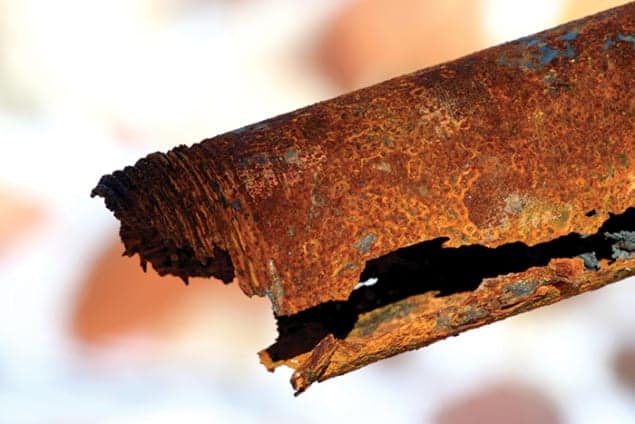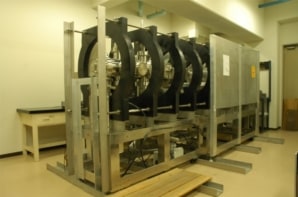Rust: the Longest War Jonathan Waldman 2015 Simon & Schuster £17.79/$26.95hb 304pp

When the US Department of Defense describes something as a “pervasive menace”, one that can tear apart aeroplanes, shut down oil pipelines and render nuclear weapons useless, most people will react by picturing a terrorist organization or hostile foreign power. The reality, though, is both more mundane and far more damaging. That destructive force is corrosion and it is the subject of science journalist Jonathan Waldman’s new book Rust: the Longest War.
The financial cost of corrosion is higher than all the more spectacular natural disasters combined, amounting to $437bn per year in the US alone, yet its slow, undramatic nature allows it to operate beneath our consciousness. Waldman recognizes that, consequently, rust is not necessarily guaranteed to hold the attention of a general audience, and he has attempted to address this problem by producing a book that is more a collection of short stories, linked by a central theme, than a single monolithic text. As a result we are treated to a tour of the field, touching on issues as diverse as the discovery of stainless steel and the maintenance of pipelines, and personalities as varied as an art photographer and a driven scientist.
The science of coatings and surfaces – the primary weapon in the fight against corrosion – is a subtle and often under-appreciated one, and the importance of getting the barrier right emerges in several chapters. Nowhere is this more clearly illustrated than in the chapter discussing the Statue of Liberty. Superficially, New York City’s famous monument appeared to be sound, yet by the 1980s substantial rot had already taken hold underneath. Rather than protecting the statue, layers of coal tar and paint had instead contributed to its decay, and attempts to clean it with bicarbonate of soda were equally disastrous. Indeed, years of superficial inspection had left its structural integrity in such a parlous state that the iconic torch was in danger of collapse, its frame not “seriously weakened”, as originally thought, but entirely absent. It was only through the tenaciousness of the statue’s caretaker – one of the multitude of unsung heroes who appear in the book – that the problems were recognized and ultimately dealt with.
While the Statue of Liberty is an example of the spectacular in terms of corrosion-related stories, Waldman does not neglect the apparently mundane. The humble aluminium can, he notes, is one of the most engineered products in the world. No surprise when we find that the pH of one popular fizzy drink – and not even the most corrosive – comes in at a nicely acidic value of 2.75. Waldman captures the ingenuity and persistence required to combat corrosion in canning, a process that took the best part of 150 years to develop, leading to the production of cans to tolerances tighter than that required for safety-critical aircraft parts.
Despite this success, canning is still a sensitive area, both in terms of the processes necessary to protect the cans and in terms of the possible long-term health impact of some coatings. Waldman’s background in environmental journalism comes to the fore here as he finds himself accepted, rejected and confusedly admitted to “Beverage Can School” (an industry course on drinks can manufacture) before being barred from “Food Can School”. The chapter illustrates the underlying tension that can sometimes arise between the mindset of scientists and engineers, who appear willing to be open about their work, and that of more senior management, who have their eye on profit and public relations and create the impression that there really is something to hide.
The largest area where corrosion specialists are active is, like the canning industry, somewhat taken for granted. Around half of corrosion engineers (the exact proportion is hard to pin down) work in oil and gas or related industries, where failure due to degradation of infrastructure can lead to catastrophic environmental damage. Inspecting an oil or gas pipeline might seem like a banal and simple job; however, it is anything but – particularly as the key is to detect and locate any damage well before failure occurs. Waldman successfully conveys the sheer magnitude of, and care needed, in such an operation, the problems that need to be overcome and the stress on those involved.
The book is squarely targeted at a non-scientific audience, and the fact that, from the beginning, Waldman labels all forms of corrosion “rust” – openly admitting that this inaccuracy will come “to the horror of engineers” – makes that clear. As a result, the book is often unsatisfying, with hints of potentially interesting and readily accessible science just visible beneath the surface. More-over, some of the chapters deviate from Waldman’s main topic to focus almost exclusively on personalities such as art photographer Alyssha Eve Csük (who specializes in photographs of rusting structures) and the Pentagon’s “corrosion ambassador” Dan Dunmire. Waldman’s account of following Csük into a disused steelworks, avoiding security guards and climbing up decrepit staircases and along pipes to get the best picture is certainly interesting, but its relevance to the rest of the book feels tenuous and it might be more at home in the colour supplement of a Sunday newspaper.
The chapters dealing primarily with the characters of individuals whose lives are dominated by corrosion also have an unfortunate tendency to play to stereotypes. It may be true that Harry Brearley (the “father of stainless steel”) was so focused on materials science that he left his wife out of his autobiography, but there is no counterbalancing portrait in Rust of a scientist or engineer as a relatively normal person. (They exist, even among the Physics World readership!) It is also saddening that the only woman given significant attention in the book is an artist rather than a scientist. Although 93% of (US registered) corrosion engineers are men, if authors reinforce stereotypical perceptions, this is not going to change any time soon.
Although the book is written from an American perspective, the author takes time to explain terms for international audiences, which is very much welcome. Less welcome are certain annoying tics in Waldman’s prose. On multiple occasions, his sentences evolve into tedious lists, and it appears, at least to a British reader of a certain age, as if he is channelling the late Clement Freud in an episode of Just a Minute on BBC Radio 4. (For those unfamiliar with the reference, Sir Clement often tried to fill his allotted minute of talking about a given subject “without repetition, hesitation or deviation” by reciting mind-numbingly long lists.) Used sparingly, such a device can convey the sheer range of points at which corrosion intersects with our lives, but the threshold from familiarity to contempt is crossed well before the mid-point of the book is reached. The odd inaccuracy – such as the description of “electrons orbiting…neutrons” rather than nuclei – further frustrates, particularly considering the book’s extremely limited scientific content. A niche for a popular work on corrosion most certainly exists, but we feel that there is just too little science and too much emphasis on personality to make this (nonetheless often absorbing and interesting) whirlwind tour of corrosion the definitive read.
- Enjoy the rest of the September 2015 issue of Physics World in our digital magazine or via the Physics World app for any iOS or Android smartphone or tablet. Membership of the Institute of Physics required



